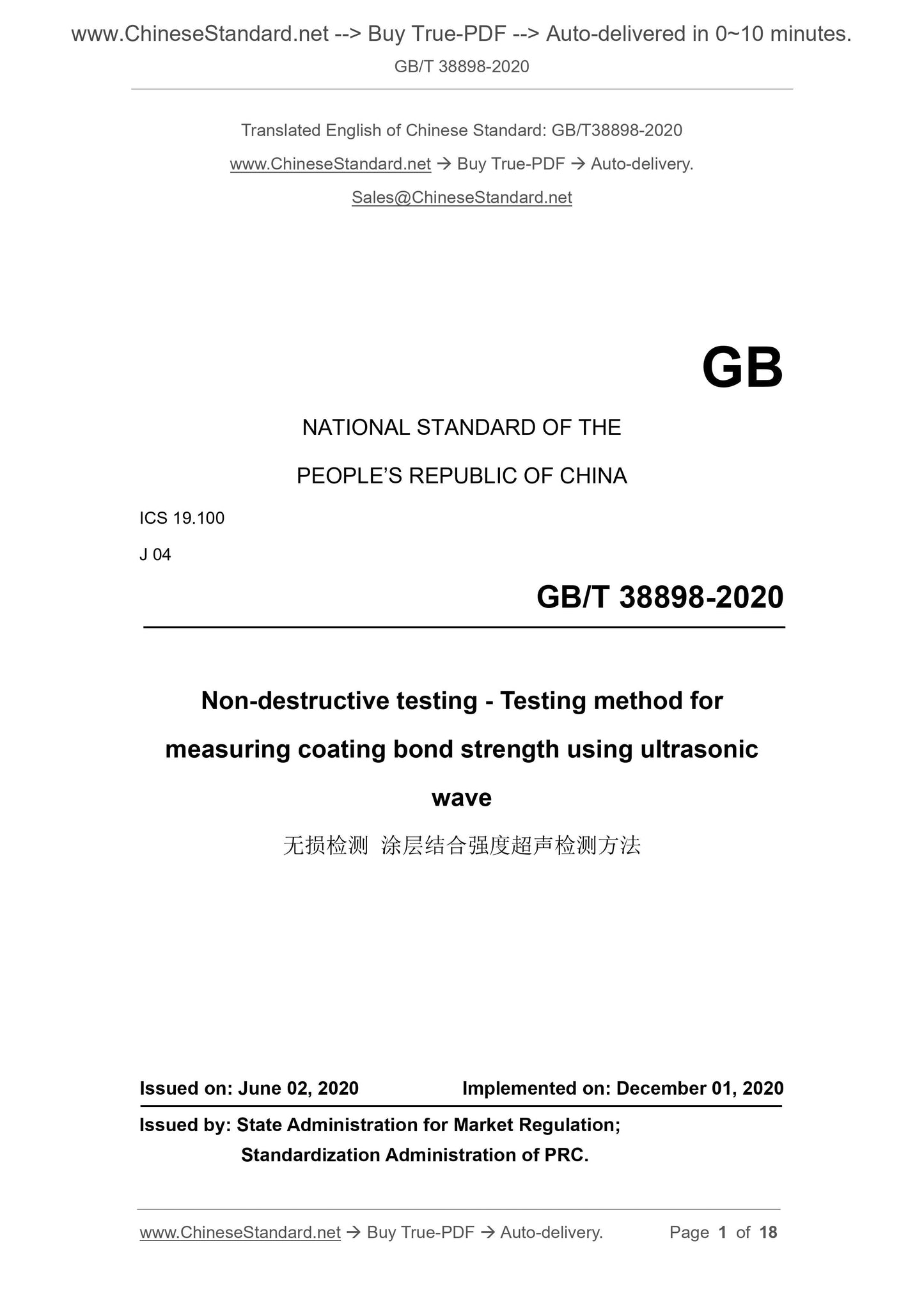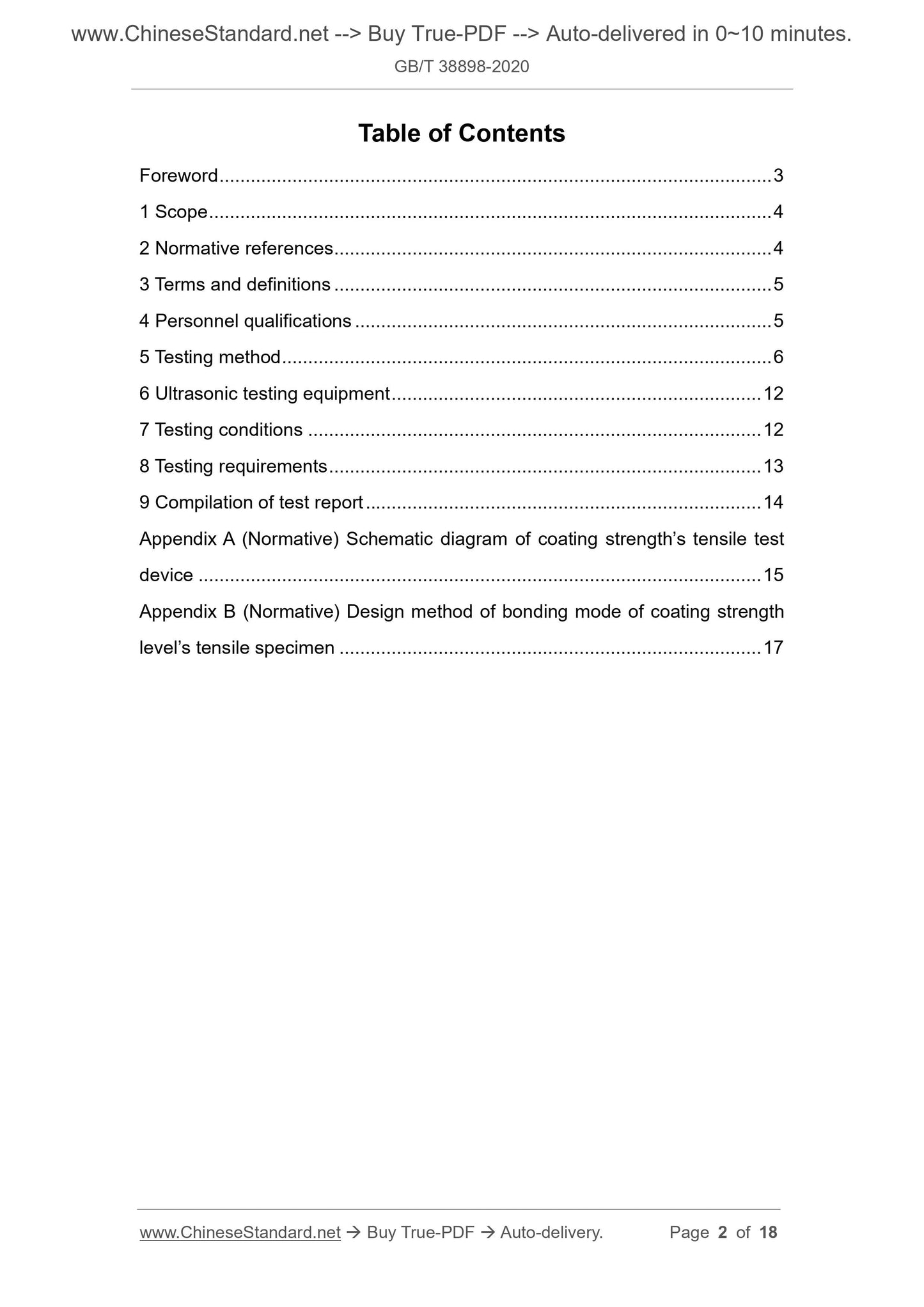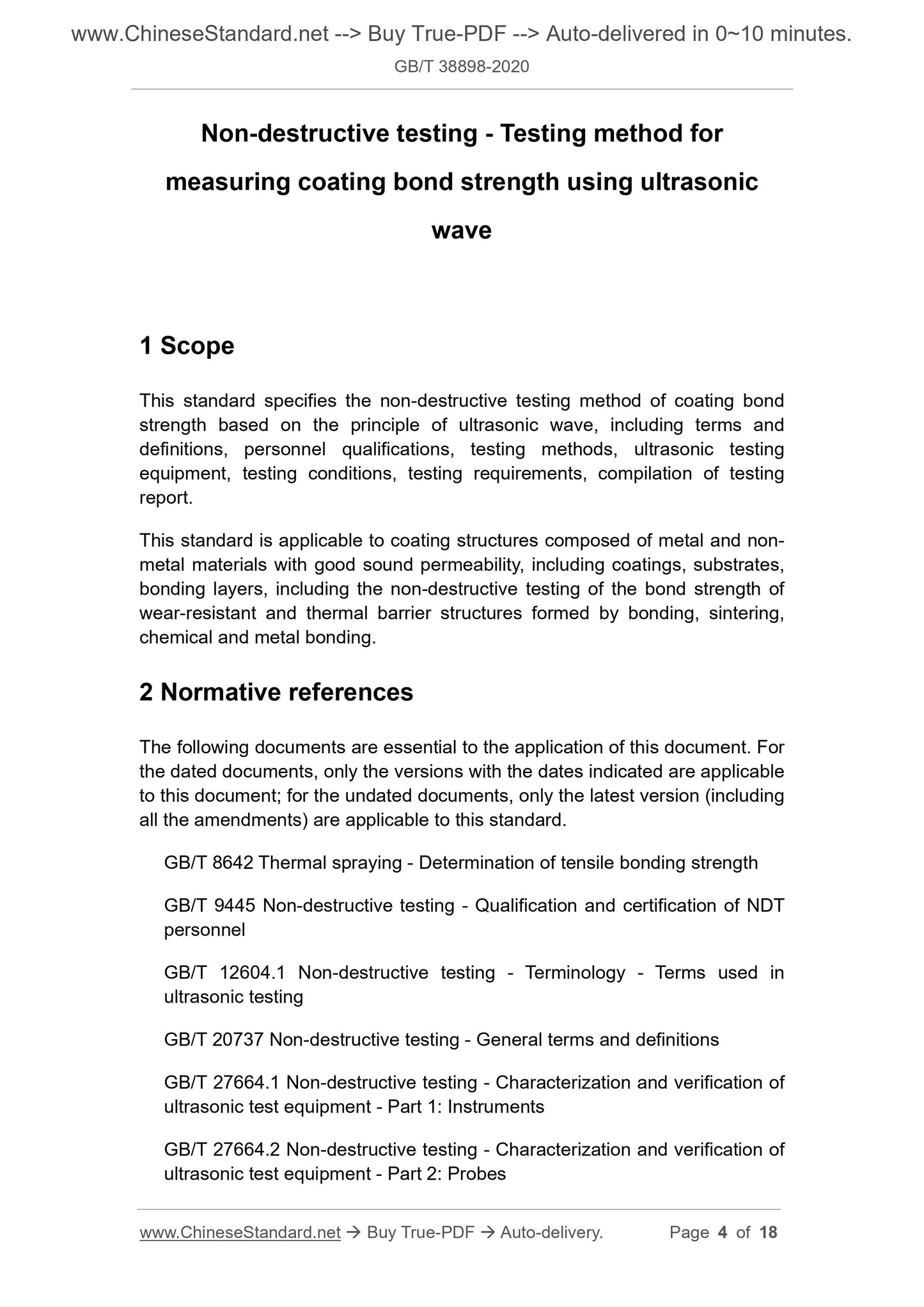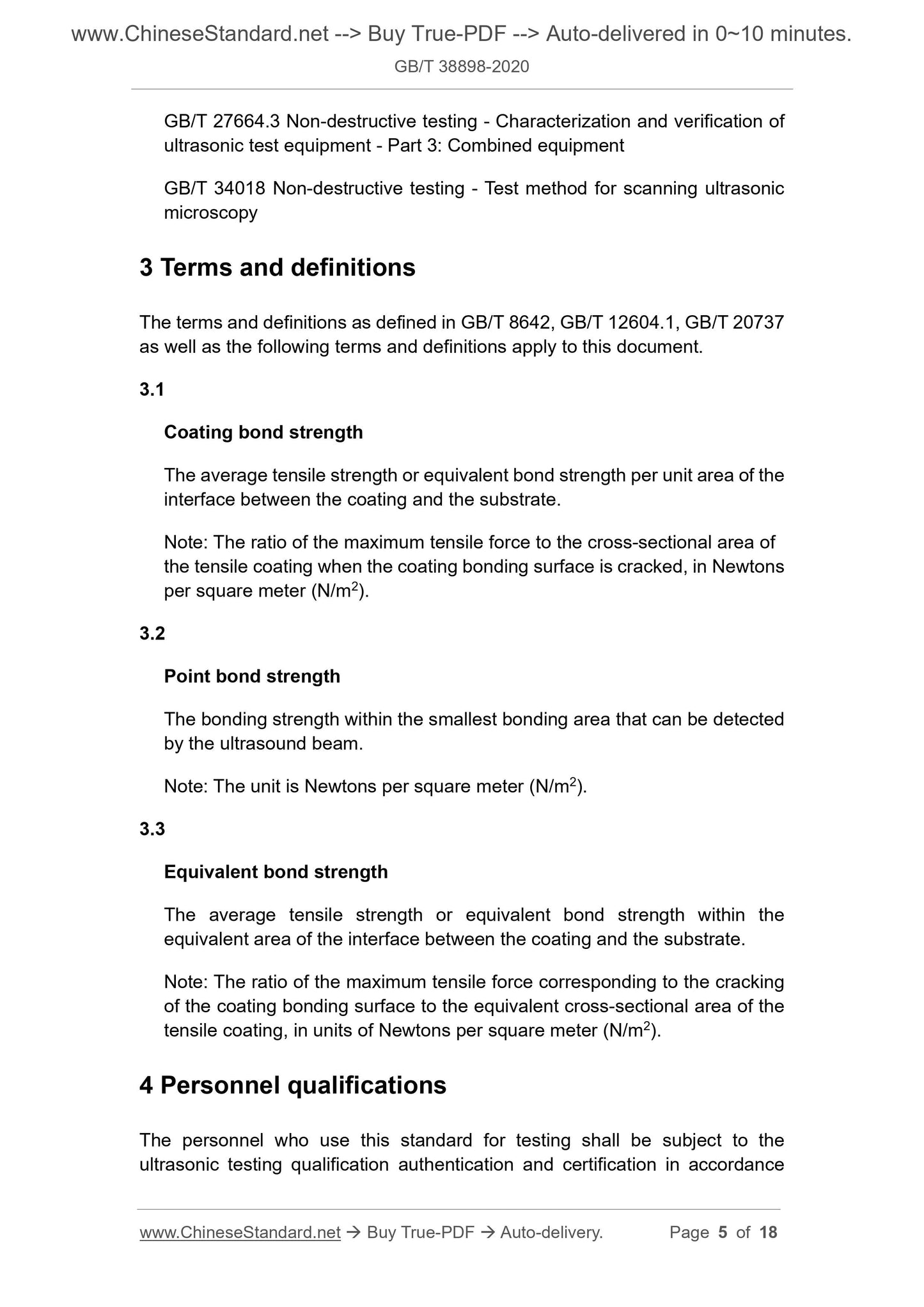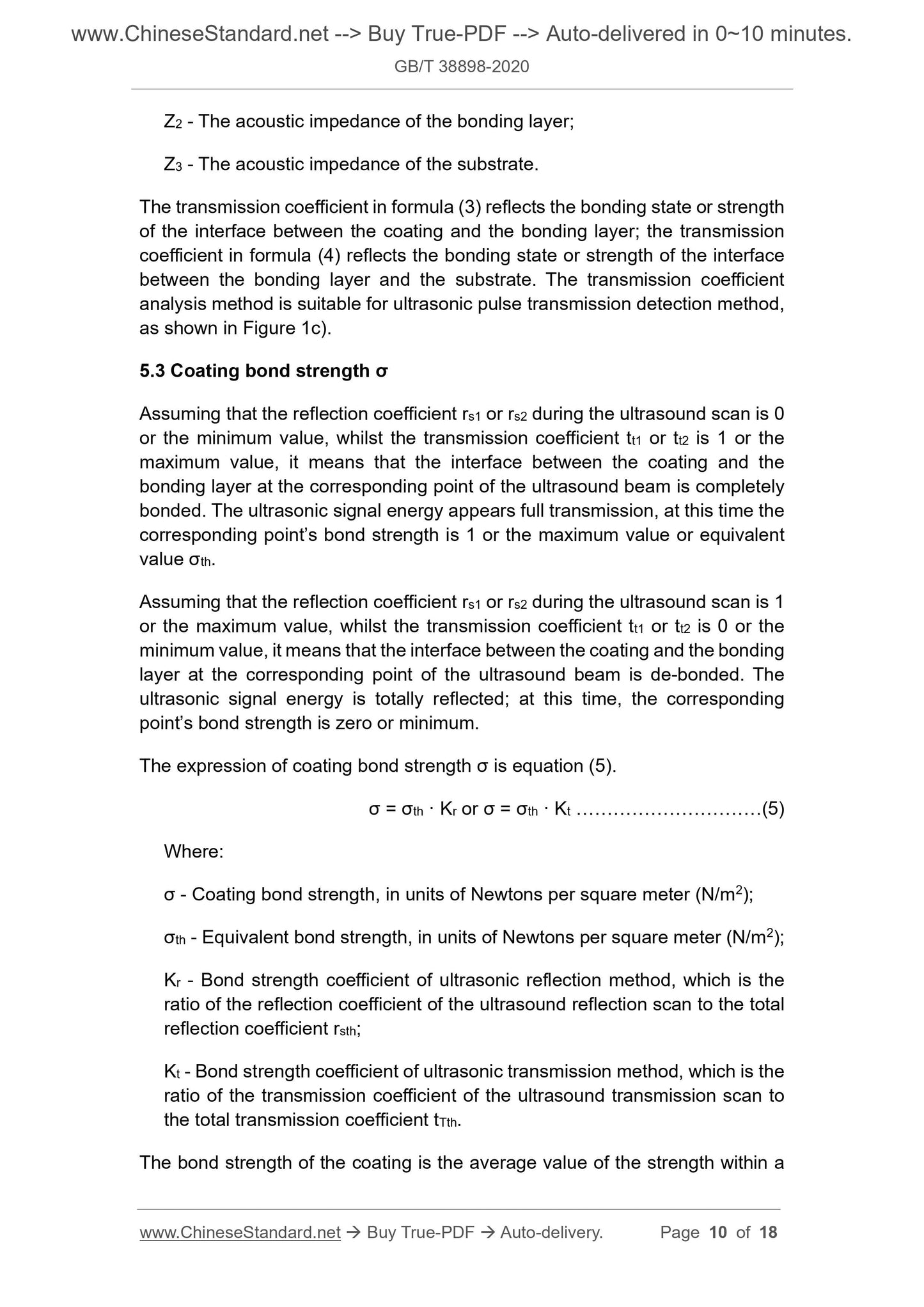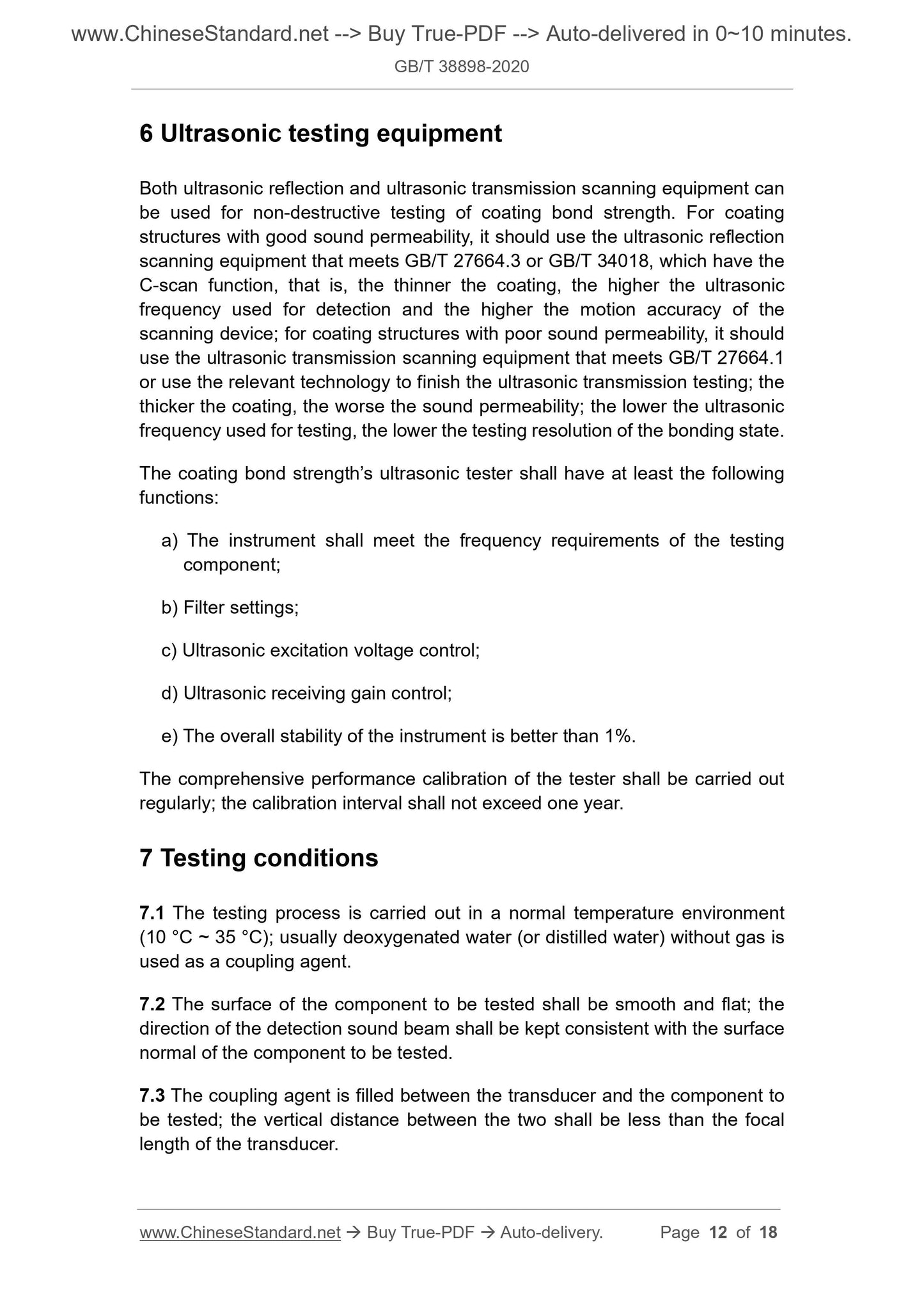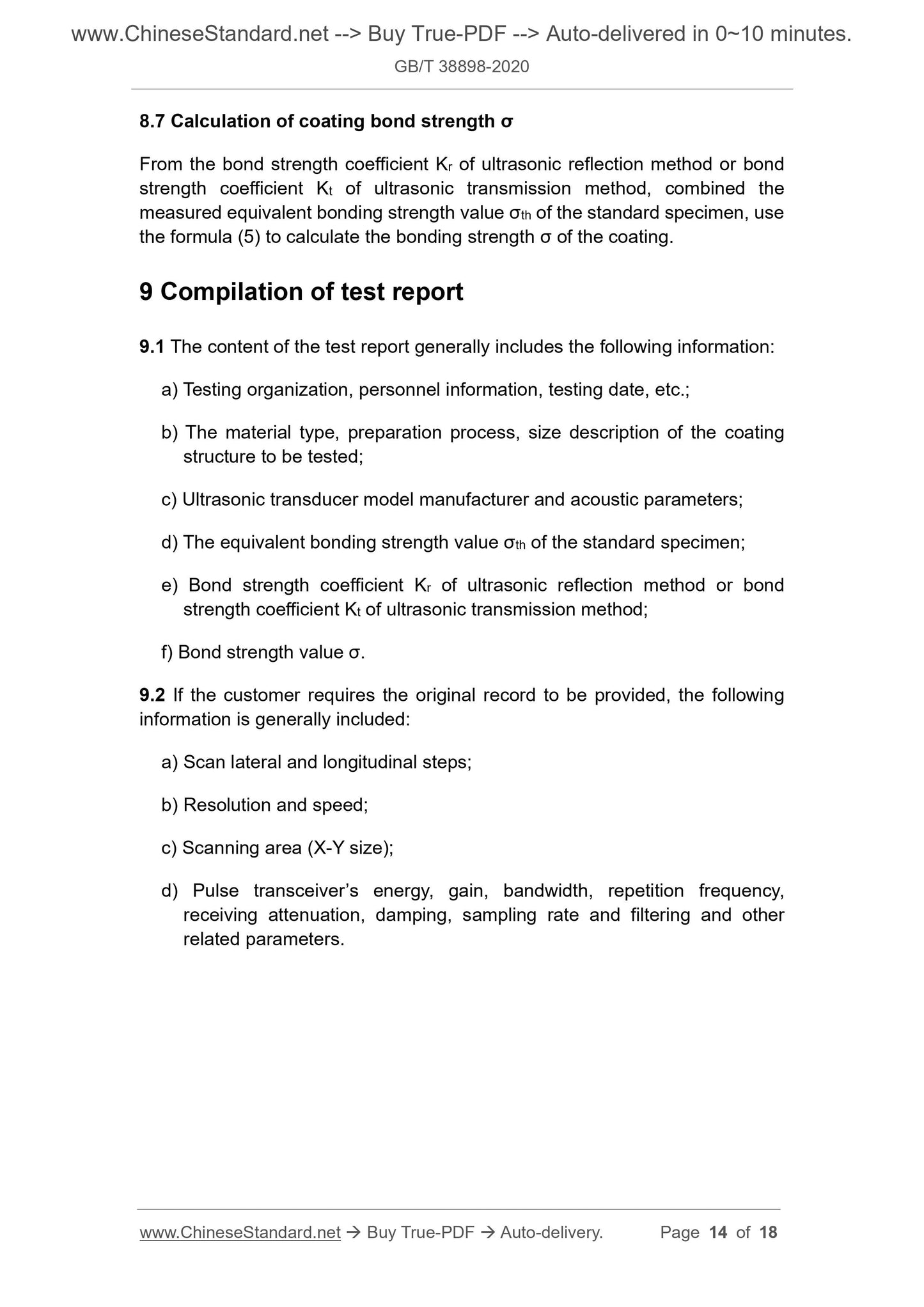1
/
of
7
PayPal, credit cards. Download editable-PDF & invoice in 1 second!
GB/T 38898-2020 English PDF (GB/T38898-2020)
GB/T 38898-2020 English PDF (GB/T38898-2020)
Regular price
$170.00 USD
Regular price
Sale price
$170.00 USD
Unit price
/
per
Shipping calculated at checkout.
Couldn't load pickup availability
Delivery: 3 seconds. Download true-PDF + Invoice.
Get QUOTATION in 1-minute: Click GB/T 38898-2020
Historical versions: GB/T 38898-2020
Preview True-PDF (Reload/Scroll if blank)
GB/T 38898-2020: Non-destructive testing--Testing method for measuring coating bond strength using ultrasonic wave
GB/T 38898-2020
GB
NATIONAL STANDARD OF THE
PEOPLE’S REPUBLIC OF CHINA
ICS 19.100
J 04
Non-destructive testing - Testing method for
measuring coating bond strength using ultrasonic
wave
ISSUED ON: JUNE 02, 2020
IMPLEMENTED ON: DECEMBER 01, 2020
Issued by: State Administration for Market Regulation;
Standardization Administration of PRC.
Table of Contents
Foreword ... 3
1 Scope ... 4
2 Normative references ... 4
3 Terms and definitions ... 5
4 Personnel qualifications ... 5
5 Testing method ... 6
6 Ultrasonic testing equipment ... 12
7 Testing conditions ... 12
8 Testing requirements ... 13
9 Compilation of test report ... 14
Appendix A (Normative) Schematic diagram of coating strength’s tensile test
device ... 15
Appendix B (Normative) Design method of bonding mode of coating strength
level’s tensile specimen ... 17
Non-destructive testing - Testing method for
measuring coating bond strength using ultrasonic
wave
1 Scope
This standard specifies the non-destructive testing method of coating bond
strength based on the principle of ultrasonic wave, including terms and
definitions, personnel qualifications, testing methods, ultrasonic testing
equipment, testing conditions, testing requirements, compilation of testing
report.
This standard is applicable to coating structures composed of metal and non-
metal materials with good sound permeability, including coatings, substrates,
bonding layers, including the non-destructive testing of the bond strength of
wear-resistant and thermal barrier structures formed by bonding, sintering,
chemical and metal bonding.
2 Normative references
The following documents are essential to the application of this document. For
the dated documents, only the versions with the dates indicated are applicable
to this document; for the undated documents, only the latest version (including
all the amendments) are applicable to this standard.
GB/T 8642 Thermal spraying - Determination of tensile bonding strength
GB/T 9445 Non-destructive testing - Qualification and certification of NDT
personnel
GB/T 12604.1 Non-destructive testing - Terminology - Terms used in
ultrasonic testing
GB/T 20737 Non-destructive testing - General terms and definitions
GB/T 27664.1 Non-destructive testing - Characterization and verification of
ultrasonic test equipment - Part 1: Instruments
GB/T 27664.2 Non-destructive testing - Characterization and verification of
ultrasonic test equipment - Part 2: Probes
GB/T 27664.3 Non-destructive testing - Characterization and verification of
ultrasonic test equipment - Part 3: Combined equipment
GB/T 34018 Non-destructive testing - Test method for scanning ultrasonic
microscopy
3 Terms and definitions
The terms and definitions as defined in GB/T 8642, GB/T 12604.1, GB/T 20737
as well as the following terms and definitions apply to this document.
3.1
Coating bond strength
The average tensile strength or equivalent bond strength per unit area of the
interface between the coating and the substrate.
Note: The ratio of the maximum tensile force to the cross-sectional area of
the tensile coating when the coating bonding surface is cracked, in Newtons
per square meter (N/m2).
3.2
Point bond strength
The bonding strength within the smallest bonding area that can be detected
by the ultrasound beam.
Note: The unit is Newtons per square meter (N/m2).
3.3
Equivalent bond strength
The average tensile strength or equivalent bond strength within the
equivalent area of the interface between the coating and the substrate.
Note: The ratio of the maximum tensile force corresponding to the cracking
of the coating bonding surface to the equivalent cross-sectional area of the
tensile coating, in units of Newtons per square meter (N/m2).
4 Personnel qualifications
The personnel who use this standard for testing shall be subject to the
ultrasonic testing qualification authentication and certification in accordance
Z2 - The acoustic impedance of the bonding layer;
Z3 - The acoustic impedance of the substrate.
The transmission coefficient in formula (3) reflects the bonding state or strength
of the interface between the coating and the bonding layer; the transmission
coefficient in formula (4) reflects the bonding state or strength of the interface
between the bonding layer and the substrate. The transmission coefficient
analysis method is suitable for ultrasonic pulse transmission detection method,
as shown in Figure 1c).
5.3 Coating bond strength σ
Assuming that the reflection coefficient rs1 or rs2 during the ultrasound scan is 0
or the minimum value, whilst the transmission coefficient tt1 or tt2 is 1 or the
maximum value, it means that the interface between the coating and the
bonding layer at the corresponding point of the ultrasound beam is completely
bonded. The ultrasonic signal energy appears full transmission, at this time the
corresponding point’s bond strength is 1 or the maximum value or equivalent
value σth.
Assuming that the reflection coefficient rs1 or rs2 during the ultrasound scan is 1
or the maximum value, whilst the transmission coefficient tt1 or tt2 is 0 or the
minimum value, it means that the interface between the coating and the bonding
layer at the corresponding point of the ultrasound beam is de-bonded. The
ultrasonic signal energy is totally reflected; at this time, the corresponding
point’s bond strength is zero or minimum.
The expression of coating bond strength σ is equation (5).
σ = σth · Kr or σ = σth · Kt …………………………(5)
Where:
σ - Coating bond strength, in units of Newtons per square meter (N/m2);
σth - Equivalent bond strength, in units of Newtons per square meter (N/m2);
Kr - Bond strength coefficient of ultrasonic reflection method, which is the
ratio of the reflection coefficient of the ultrasound reflection scan to the total
reflection coefficient rsth;
Kt - Bond strength coefficient of ultrasonic transmission method, which is the
ratio of the transmission coefficient of the ultrasound transmission scan to
the total transmission coefficient tTth.
The bond strength of the coating is the average value of the strength within a
6 Ultrasonic testing equipment
Both ultrasonic reflection and ultrasonic transmission scanning equipment can
be used for non-destructive testing of coating bond strength. For coating
structures with good sound permeability, it should use the ultrasonic reflection
scanning equipment that meets GB/T 27664.3 or GB/T 34018, which have the
C-scan function, that is, the thinner the coating, the higher the ultrasonic
frequency used for detection and the higher the motion accuracy of the
scanning device; for coating structures with poor sound permeability, it should
use the ultrasonic transmission scanning equipment that meets GB/T 27664.1
or use the relevant technology to finish the ultrasonic transmission testing; the
thicker the coating, the worse the sound permeability; the lower the ultrasonic
frequency used for testing, the lower the testing resolution of the bonding state.
The coating bond strength’s ultrasonic tester shall have at least the following
functions:
a) The instrument shall meet the frequency requirements of the testing
component;
b) Filter settings;
c) Ultrasonic excitation voltage control;
d) Ultrasonic receiving gain control;
e) The overall stability of the instrument is bett...
Get QUOTATION in 1-minute: Click GB/T 38898-2020
Historical versions: GB/T 38898-2020
Preview True-PDF (Reload/Scroll if blank)
GB/T 38898-2020: Non-destructive testing--Testing method for measuring coating bond strength using ultrasonic wave
GB/T 38898-2020
GB
NATIONAL STANDARD OF THE
PEOPLE’S REPUBLIC OF CHINA
ICS 19.100
J 04
Non-destructive testing - Testing method for
measuring coating bond strength using ultrasonic
wave
ISSUED ON: JUNE 02, 2020
IMPLEMENTED ON: DECEMBER 01, 2020
Issued by: State Administration for Market Regulation;
Standardization Administration of PRC.
Table of Contents
Foreword ... 3
1 Scope ... 4
2 Normative references ... 4
3 Terms and definitions ... 5
4 Personnel qualifications ... 5
5 Testing method ... 6
6 Ultrasonic testing equipment ... 12
7 Testing conditions ... 12
8 Testing requirements ... 13
9 Compilation of test report ... 14
Appendix A (Normative) Schematic diagram of coating strength’s tensile test
device ... 15
Appendix B (Normative) Design method of bonding mode of coating strength
level’s tensile specimen ... 17
Non-destructive testing - Testing method for
measuring coating bond strength using ultrasonic
wave
1 Scope
This standard specifies the non-destructive testing method of coating bond
strength based on the principle of ultrasonic wave, including terms and
definitions, personnel qualifications, testing methods, ultrasonic testing
equipment, testing conditions, testing requirements, compilation of testing
report.
This standard is applicable to coating structures composed of metal and non-
metal materials with good sound permeability, including coatings, substrates,
bonding layers, including the non-destructive testing of the bond strength of
wear-resistant and thermal barrier structures formed by bonding, sintering,
chemical and metal bonding.
2 Normative references
The following documents are essential to the application of this document. For
the dated documents, only the versions with the dates indicated are applicable
to this document; for the undated documents, only the latest version (including
all the amendments) are applicable to this standard.
GB/T 8642 Thermal spraying - Determination of tensile bonding strength
GB/T 9445 Non-destructive testing - Qualification and certification of NDT
personnel
GB/T 12604.1 Non-destructive testing - Terminology - Terms used in
ultrasonic testing
GB/T 20737 Non-destructive testing - General terms and definitions
GB/T 27664.1 Non-destructive testing - Characterization and verification of
ultrasonic test equipment - Part 1: Instruments
GB/T 27664.2 Non-destructive testing - Characterization and verification of
ultrasonic test equipment - Part 2: Probes
GB/T 27664.3 Non-destructive testing - Characterization and verification of
ultrasonic test equipment - Part 3: Combined equipment
GB/T 34018 Non-destructive testing - Test method for scanning ultrasonic
microscopy
3 Terms and definitions
The terms and definitions as defined in GB/T 8642, GB/T 12604.1, GB/T 20737
as well as the following terms and definitions apply to this document.
3.1
Coating bond strength
The average tensile strength or equivalent bond strength per unit area of the
interface between the coating and the substrate.
Note: The ratio of the maximum tensile force to the cross-sectional area of
the tensile coating when the coating bonding surface is cracked, in Newtons
per square meter (N/m2).
3.2
Point bond strength
The bonding strength within the smallest bonding area that can be detected
by the ultrasound beam.
Note: The unit is Newtons per square meter (N/m2).
3.3
Equivalent bond strength
The average tensile strength or equivalent bond strength within the
equivalent area of the interface between the coating and the substrate.
Note: The ratio of the maximum tensile force corresponding to the cracking
of the coating bonding surface to the equivalent cross-sectional area of the
tensile coating, in units of Newtons per square meter (N/m2).
4 Personnel qualifications
The personnel who use this standard for testing shall be subject to the
ultrasonic testing qualification authentication and certification in accordance
Z2 - The acoustic impedance of the bonding layer;
Z3 - The acoustic impedance of the substrate.
The transmission coefficient in formula (3) reflects the bonding state or strength
of the interface between the coating and the bonding layer; the transmission
coefficient in formula (4) reflects the bonding state or strength of the interface
between the bonding layer and the substrate. The transmission coefficient
analysis method is suitable for ultrasonic pulse transmission detection method,
as shown in Figure 1c).
5.3 Coating bond strength σ
Assuming that the reflection coefficient rs1 or rs2 during the ultrasound scan is 0
or the minimum value, whilst the transmission coefficient tt1 or tt2 is 1 or the
maximum value, it means that the interface between the coating and the
bonding layer at the corresponding point of the ultrasound beam is completely
bonded. The ultrasonic signal energy appears full transmission, at this time the
corresponding point’s bond strength is 1 or the maximum value or equivalent
value σth.
Assuming that the reflection coefficient rs1 or rs2 during the ultrasound scan is 1
or the maximum value, whilst the transmission coefficient tt1 or tt2 is 0 or the
minimum value, it means that the interface between the coating and the bonding
layer at the corresponding point of the ultrasound beam is de-bonded. The
ultrasonic signal energy is totally reflected; at this time, the corresponding
point’s bond strength is zero or minimum.
The expression of coating bond strength σ is equation (5).
σ = σth · Kr or σ = σth · Kt …………………………(5)
Where:
σ - Coating bond strength, in units of Newtons per square meter (N/m2);
σth - Equivalent bond strength, in units of Newtons per square meter (N/m2);
Kr - Bond strength coefficient of ultrasonic reflection method, which is the
ratio of the reflection coefficient of the ultrasound reflection scan to the total
reflection coefficient rsth;
Kt - Bond strength coefficient of ultrasonic transmission method, which is the
ratio of the transmission coefficient of the ultrasound transmission scan to
the total transmission coefficient tTth.
The bond strength of the coating is the average value of the strength within a
6 Ultrasonic testing equipment
Both ultrasonic reflection and ultrasonic transmission scanning equipment can
be used for non-destructive testing of coating bond strength. For coating
structures with good sound permeability, it should use the ultrasonic reflection
scanning equipment that meets GB/T 27664.3 or GB/T 34018, which have the
C-scan function, that is, the thinner the coating, the higher the ultrasonic
frequency used for detection and the higher the motion accuracy of the
scanning device; for coating structures with poor sound permeability, it should
use the ultrasonic transmission scanning equipment that meets GB/T 27664.1
or use the relevant technology to finish the ultrasonic transmission testing; the
thicker the coating, the worse the sound permeability; the lower the ultrasonic
frequency used for testing, the lower the testing resolution of the bonding state.
The coating bond strength’s ultrasonic tester shall have at least the following
functions:
a) The instrument shall meet the frequency requirements of the testing
component;
b) Filter settings;
c) Ultrasonic excitation voltage control;
d) Ultrasonic receiving gain control;
e) The overall stability of the instrument is bett...
Share
